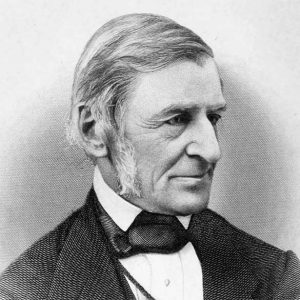Rowan Beckford
The brief poem “Let me not thirst with this Hock at my Lip” is concerned with a dichotomy of poetic wealth and impoverishment. It is intensively perceived, subjective, and ushers the reader into the world of what Emerson calls “ulterior intellectual perception” (Emerson 72). This follows Emerson’s declaration that “all are emblems,” meaning that all things—persons, objects, words, even concepts—are representative of other things (72). So, according to Emerson, it is an “ulterior intellectual perception” that is the poet’s particular means for articulating what is represented by various so-called “emblems”. Emerson poeticizes this concept with the premise that “[l]anguage is fossil poetry,” (73) asserting that the work of the poet is the revival of language that has become so familiar as to have lost meaning.
It is not that there is nothing sufficient for the poet to create poetry, but that the struggle of the poet is to vitalize their subject. The speaker of Dickinson’s poem recognizes that there is no lack of subjects for poetry, according with the expanse implied by Emerson’s affirmation that all subjects are emblematic and worthy of poetry. The speaker is met with a surplus of possibilities, which, in another Dickinson poem, “I dwell in Possibility —,” figures as a point of celebration rather than a dilemma. Here, however, the speaker is pleading for the ability to articulate emblems into poetry, even as possibility is emblematized by the “Hock” (recall that poetry is “God’s wine”) and pocketed “Domains” (Dickinson 715; Emerson 76). It is a compromised bounty. Emerson remarks that certain subjects are not yet consecrated into poetry. The poet must assume the role of arbiter and determine for themselves what is fit to be the subject of their poems. This act of individuation comes, as Emerson notes, at the cost of bearing accusations of “fool” and “churl” (82). But it is for this act—for “actions are a kind of words”—that the poet participates in poetry, “written before all time was” (Emerson 67).
Emerson dubs the poet the “only teller of news” (67). The analogue of this idea is found in “The Poets light but Lamps —”, where the poet assumes the role of teller, as opposed to the “winged man,” who deceives and “does not know the way into the heavens” (Emerson 69). The speaker then introduces a kind of formula describing poetic immortality. Detached from metaphorical language, the formula is that though poets die, their poems may survive them and proliferate their presence.
The Poets light but Lamps —
Themselves — go out —
The Wicks they stimulate
If vital Light
Inhere as do the Suns —
Each Age a Lens
Disseminating their
Circumference — (Dickinson 415)
Poems, emblematized here as “Wicks,” if lit by “vital Light” (the conditional mood is crucial), proleptically render each succeeding age “a Lens” (Dickinson 415). The poem survives its author and is read by generations who, in their diverse readings of the poem, amplify and expand its meanings and influence. The greatest of poems attain an essential place in the order of tradition as suns prove essential in the order of stars. Emerson writes that there are “no limits to their works, except the limits of their lifetime,” and like a mirror the works come to “render an image of every created thing” (Emerson 81). Dickinson describes this as “Disseminating their Circumference” (415).
Circumference, perhaps the most elusive trope of Dickinson’s poetry, requires much more discussion and reference than possible here. (Hypothetically, this would begin with study of several other Dickinson poems, Emerson’s essay “Circles”, and an overview of the sublime). Nevertheless, I suggest it is related to the unlocking of one’s “human doors” and “suffering [of] the ethereal tides” (Emerson 75). If we understand the dissemination of the poem’s circumference as a further extension of influence and consider St. Augustine’s claim—digested by Emerson in the first paragraph of “Circles”—God’s nature as a circle whose center is everywhere and whose circumference is nowhere, the notion of circumference as unbounded sublime is affirmed.
“Say, ‘It is in me, and shall out!,” Emerson encourages the would-be poet (81). His command is akin to a sentiment of the prophet Jeremiah: “the word was in mine heart as a burning fire shut up in my bones,” (King James Version, Jer. 20:8-9) and as the prophet cries out, the poet must cry out. And rarely is it as intense as in Dickinson’s poem “I taste a liquor never brewed —”. The final stanza is emblematic of poetic consummation: seraphs doff their hats and saints hurry to glimpse the self-professed “tippler” ascend and lean against the sun, the poet imbibed with poetry (99). What could be more liberating or more godlike than to lean against the sun not only unhurt but in reverie? The poem is ludic flight.
Reading Dickinson, one decidedly thinks of her as the tippler, surely of the kind and class of poet Emerson had in mind when writing the apostrophe that closes “The Poet”: “though thou shouldest walk the world over, thou shalt not be able to find a condition inopportune or ignoble” (82). O poet, indeed.
Works Cited
Dickinson, Emily. The Complete Poems of Emily Dickinson. Edited by Thomas Herbert Johnson, Little, Brown and Company, 2015.
Emerson, Ralph Waldo. “The Poet.” Self-Reliance and Other Essays, edited by Stanley Appelbaum, by Ralph Waldo Emerson, Dover Publications, Incorporated, 1993, pp. 65–82.
The Holy Bible, King James Version, Christian Art Publishers, 2016.
How to cite this post
Rowan Beckford. “Breathing Through Forms: The Influence of ‘The Poet’ on the Poems of Dickinson.” The Transparent Eyeball, Second Series, The Ralph Waldo Emerson Society, Feb. 26, 2021, emersonsociety.org/the-transparent-eyeball/breathing-through-forms-the-influence-of-the-poet-on-the-poems-of-dickinson/. Accessed [date of access; ex. 5 Aug. 2021].
Beckford, R. (2021, Feb. 26). Breathing Through Forms: The Influence of “The Poet” on the Poems of Dickinson. The Transparent Eyeball. https://emersonsociety.org/the-transparent-eyeball/breathing-through-forms-the-influence-of-the-poet-on-the-poems-of-dickinson/.
Beckford, Rowan. “Breathing Through Forms: The Influence of ‘The Poet’ on the Poems of Dickinson,” The Ralph Waldo Emerson Society. The Transparent Eyeball, Feb. 26, 2021, https://emersonsociety.org/the-transparent-eyeball/breathing-through-forms-the-influence-of-the-poet-on-the-poems-of-dickinson/.
